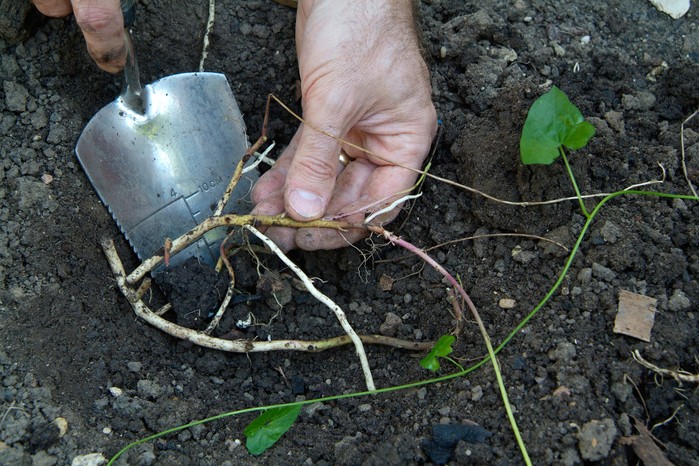
Bindweed is a perennial weed that can become a persistent problem in gardens. There are two types: hedge bindweed and field bindweed. The most familiar and problematic bindweed is hedge bindweed, Calystegia sepium, which is fast-growing with slender, twining stems and large white trumpet flowers. It can grow to form a large mass of foliage, choking garden plants, reducing their growth or killing smaller plants entirely. Field bindweed, Convulvulus arvensis, bears smaller pink or white trumpet flowers and is smaller and less vigorous overall, although still perennial and problematic, especially on bare soil.
More advice on tackling weeds:
Why is bindweed a problem?
Bindweed is long-lived and hard to get rid of, especially when it’s growing amongst garden plants, because the fast-growing root system grows right through the roots of other plants. Hedge bindweed is a particular nuisance, being fast-growing with roots that can grow well over a metre a year and stems that can reach several metres high. The creamy-white roots are brittle and break easily, and even the smallest piece left in the ground will develop into a new plant. Field bindweed is less vigorous, but the same issues apply with the brittle roots and twining stems.
How to control bindweed without chemicals
Bindweed roots being dug out with a trowel
If you can wait 12-18 months before planting, the easiest way to kill all perennial weeds is to cover the soil with something that excludes all light. Plants need light in order to make food, so in the dark, even the toughest weeds will succumb in time. Use a material such as weed control fabric, black polythene or old carpet. It’s important to weigh down or bury the edges to keep out all light.
- In beds and borders, digging out bindweed roots is the only way to tackle this problematic weed. Winter to early spring is a good time to get on top of it, before plants start growing.
- Every piece of root left in the soil will grow into a new plant, so remove every last bit wherever possible. Use a fork to avoid breaking up the root.
- Where bindweed has grown through the root systems of established plants, loosen the soil on each side of the roots to carefully pull out entire pieces.
- Herbaceous perennials and ornamental grasses that are full of bindweed can be lifted and divided whilst dormant and the bindweed removed.
- In summer, if it’s not possible to dig up roots, hoe, cut or pull off shoots to weaken growth.
- Other chemical-free weed control methods, such as homemade weed killers and weed burners, also kill top growth and weaken the weed but won’t kill the roots.
Disposing of bindweed roots

Bindweed roots on a garden fork
Never put bindweed roots in a compost bin as they will survive and can be spread around the garden when you use the compost. The roots can be safely composted in stout black plastic sacks (a good use for old compost bags) by folding over the top of the bag to keep out light and leaving for at least a year. Bindweed can be disposed of in your garden waste collection or taken to your council recycling centre.
How to control bindweed using chemical weedkillers

Spraying bindweed with a systemic weedkiller
As bindweed is a perennial weed, it can only be completely killed with the systemic weedkiller glyphosate. This needs to be applied to the leaves, which is then taken down into the roots as bindweed grows. Other types of weedkiller will kill only the top growth, and bindweed simply regrows from the roots.
Glyphosate comes in several formulations including gel, ready to use spray or concentrate, which you dilute and apply in your own sprayer. Make sure you always follow all safety instructions – glyphosate is thought to be linked to various human cancers and has been banned for municipal use by many UK councils. Apply glyphosate to the foliage only, from when bindweed starts flowering in summer through to early autumn. Take great care to avoid getting this weedkiller on garden plants as it kills everything it touches.
Where bindweed is growing among garden plants, put canes in the ground for the bindweed to twine up. Then, simply slip the growth off the cane, put into a clear plastic bag (still attached to the roots), apply glyphosate, and secure the bag with a clothes peg. Leave in place until the bindweed is completely dead.
